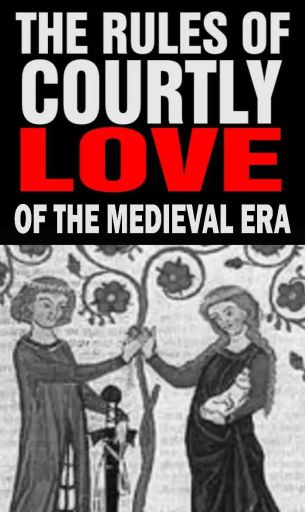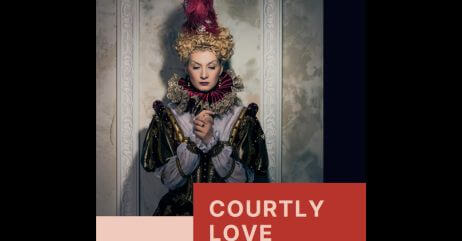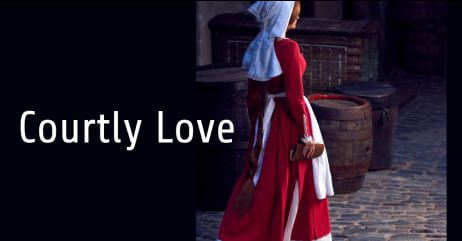Last updated on July 25th, 2024 at 07:50 am
Here are the bittersweet rules of courtly love in medieval Europe that guided romantic affairs in Medieval Europe courts, highlighting chivalry and secrecy.
In the grand halls of medieval courts, a unique form of love blossomed, governed by a set of rules and guides.
Courtly love, a concept that drove knights and noblewomen alike, was driven by its unattainability, secrecy, a taint of taboo, and the worship of the beloved who is on a pedestal.
From necessary jealousy to the injection of chivalry, these rules of courtly love influenced romance in the Middle Ages.
Here are some examples of popular courtly romances.
You might want to pin the image below.

The Implication of the Rules of Courtly Love
The rules of courtly love served as a base for romantic relationships in medieval times.
It influenced the expression of art both in music and literature and had a profound influence on relationships.
The rule of courtly love put the status of women on a pedestal, portraying them as figures that fueled noble acts.
It also paved the way for poetry and art traditions that centered on love.
Also, on the contrary, the rules of courtly love expressed the dark side of love, especially in secrecy outside marriage, which makes it somehow a legalization of taboo.
While this drives curiosity, it also complicates the moral path of love, tainted with jealousy and possessiveness which causes emotional turmoil and sometimes leads to violence.
Related: The Meaning of Chivalry
10 Rules of Courtly Love
These rules were highly idealized and poetic, often portrayed in literature and art of the time.
1. Admiration
Admiration is integral to courtly love, one of the medieval rules of courtly love shaping noble relationships.
The lover, typically a knight, reveres the lady’s virtues—beauty, intelligence, grace—expressed through poetry and noble deeds.
Admiration serves purposes: idealizing the lady’s allure, motivating chivalrous quests, and emphasizing love’s divine nature.
It reflects respect and veneration, seeking the lady’s favour beyond physical attraction.
Yet, courtly love’s ideals were often literary or poetic, influenced by troubadour poetry and romance literature.
Admiration in courtly love elevates ladies to near-divine status, urging knights to embody chivalric virtues while pursuing an unattainable ideal.
Related: Modern Acts of Chivalry for Modern Times
2. Risky and Dangerous
Another of the rules of courtly love is risky. In courtly love, the risky rule underlines the challenge and risk inherent in love the knight has to undergo, demanding them demonstrate sincerity by embracing risks.
The noblewomen who are mostly married also stand the risk of being caught by their husbands and societal stigma.
Love necessitates going to great lengths, even jeopardizing reputation, status, or safety.
The concept’s peril is heightened by common adultery, forbidden relationships, and societal obligations.
Secret rendezvous and impassioned letters risked exposure and scandal.
Courtly love often demanded dangerous feats, such as perilous journeys and knightly combat, showcasing unwavering dedication.
This rule aimed to elevate love, symbolizing loyalty and bravery, exemplifying exceptional devotion to the beloved, and underscoring the commitment’s genuineness.
By embracing risk, courtly lovers aspired to ascend love to a noble, commendable level.

3. Worship
Worship, one of the rules of courtly love, involves the adoration and devotion knights show toward their chosen noblewomen.
Originating in the medieval period, this concept emphasizes the knight’s deep respect, placing the lady on a pedestal as an almost divine figure.
Knights were expected to demonstrate loyalty through acts of chivalry, such as valiant deeds in her honor, while also forming a profound emotional connection.
They idealized the lady as a paragon of beauty and virtue, expressing their devotion through poetry and songs.
Worship served as a means of self-improvement, motivating knights to embody the high ideals represented by their beloved.
Related: Lessons from the Code of Chivalry
4. Chivalry
Chivalry, a fundamental rule of courtly love, is a code of conduct that defined knights’ behavior towards noblewomen in medieval Europe.
Originating in the 12th century within troubadour culture, chivalry emphasized respect, politeness, and honorable actions, highlighting the protection and welfare of women.
Knights pledged loyalty to often unattainable noblewomen, expressing their devotion through poetry and acts of service.
Chivalry dictated that knights treat women with utmost respect, addressing them with admiration and attributing divine qualities to them.
Additionally, knights were responsible for safeguarding their ladies’ physical and emotional well-being, defending their reputation and ensuring they were treated with dignity.
Related: Genuine Reasons why Chivalry is not Dead

5. Unattainability
Unattainability is one of the rules of courtly love that defined relationships between knights and noblewomen in medieval times.
This concept posits that the knight’s beloved, often a married or betrothed noblewoman, is seen as unattainable, intensifying the knight’s longing and desire.
Factors such as social status, marital commitments, or the knight’s lack of noble birth contribute to this unattainability.
Knights were expected to pursue their ladies from a respectful distance, adhering to a code of conduct that emphasized courtesy, loyalty, and honor.
This dynamic not only created romantic idealism but also elevated the noblewoman’s status as a figure of beauty and virtue.
Related: Examples of Chivalry Behaviours Men Should Master
6. Secrecy and Discretion
Secrecy and discretion were among the rules of courtly love between knights and noblewomen during the medieval period.
The secrecy involved keeping the relationship hidden from public scrutiny, reflecting societal constraints where marriages were often arranged for political or economic reasons.
Courtly love offered an outlet for forbidden passions, making it crucial to avoid scandal and potential punishment.
Discretion required both parties to exercise caution and restraint, maintaining control over their emotions and actions to project a chaste and virtuous relationship.
This was particularly vital for noblewomen, as any hint of impropriety could jeopardize their reputation and social standing.
Related: The Medieval Code of Chivalry
7. Service and Deference
Service and deference were among the rules of courtly love that defined relationships between knights and noblewomen during the medieval era.
Service involves the knight’s commitment to serve and protect his beloved noblewoman, demonstrating loyalty and obedience by performing valiant feats to prove his worthiness.
Deference refers to the knight’s respect and reverence for the noblewoman, upholding her social status and prioritizing her happiness and well-being above his own.
These rules establish a hierarchical structure, with the knight as the protector and the noblewoman as the cherished figure, creating a romanticized ideal of love that embodies chivalry, honor, and devotion.
8. Jealousy
In courtly love, jealousy is a key rule governing relationships.
It embodies the knight’s possessiveness and protectiveness towards his lady, while the lady inspires jealousy in her knight.
This rule reflects the belief that love should be intense, passionate, and exclusive. Jealousy fosters competition among knights, motivating them to win their lady’s favor and reinforcing the notion of love as a contest.
It heightens commitment, as the fear of losing the beloved strengthens the knight’s devotion.
The lady’s ability to inspire jealousy by attracting other suitors helps maintain the knight’s interest and loyalty, testing their faithfulness.
9. Suffering and Longing
Courtly love was characterized by suffering and longing. Suffering in courtly love refers to the idea that love must entail some degree of pain or sacrifice.
It suggests that love is not easily attainable, and the longing for the beloved becomes a defining feature of the courtly experience.
Knights would often pine or yearn for the unattainable love of a noblewoman, suffering in their longing for her affection.
This suffering was seen as a noble and virtuous way to prove devotion and dedication.
Longing, on the other hand, represents the intense desire or yearning for the beloved.
Knights were expected to pine for their beloved, constantly thinking of her, and expressing their longing through poetic devices such as imagery, metaphors, and themes of unrequited love.
The longing was seen as an essential part of courtly love, providing a heightened emotional experience and enhancing the idealized nature of the relationship.
10. Love from Afar
Love from afar, or amor de lonh, was a central rule of courtly love during the Middle Ages.
This concept involved a love that could not be fully consummated due to obstacles like distance and social boundaries.
Knights, often separated from their beloveds by quests and conflicts, idolized their noblewomen as unreachable figures, promoting a spiritual and emotional connection celebrated for its intensity and purity.
This unattainability inspired knights to embody chivalrous qualities such as honor, loyalty, and bravery, motivating them to strive for excellence.
Ultimately, love from afar elevated romantic ideals while emphasizing emotional and spiritual bonds.
11. When One Lover Dies, a Widowhood of Two Years is Required
When one lover dies, a widowhood of two years is required is a rule of courtly love that emphasizes the importance of mourning and respect for the deceased.
This guideline dictates that a knight or noblewoman should refrain from pursuing new romantic relationships for two years following the loss of their beloved.
This period of mourning allows for emotional healing and honors the memory of the departed, reinforcing the ideals of loyalty and devotion inherent in courtly love.
11. Boys Do not Love Until they Reach the Age of Maturity
This is a rule of courtly love indicating that true love requires emotional and psychological development.
This guideline suggests that youthful infatuation lacks the depth and seriousness associated with genuine romantic feelings.
Maturity is necessary for understanding the complexities of love, including loyalty, respect, and devotion.
By emphasizing this distinction, the rule underscores the idealized nature of courtly love, where meaningful relationships are reserved for those who have attained the necessary maturity to appreciate them fully.
Final Words from Gentsways
The etiquette and rules of courtly love held great importance in medieval courts, serving as a structured and refined code of conduct for nobility and the aristocracy.
These principles established guidelines for romantic relationships, emphasizing chastity, secrecy, and devotion.
The practice of courtly love allowed individuals to express their desires and emotions within the boundaries of social expectations.
It provided a framework for courtly behaviour, promoting refinement, courtesy, and respect.
While courtly love may seem idealistic and romanticized today, it played a significant role in shaping medieval society, influencing literature, art, and courtly rituals for generations to come.
References:
- http://faculty.sgc.edu/rkelley/rulesoflove.htm
- https://thebohemianrockstarpresents.wordpress.com/2014/02/08/a-look-at-the-rules-of-courtly-love-by-andreas-capellanus-rules-1-through-10/
- https://www.alyve.org/chs/english/apenglishlit/documents/courtly_love.pdf
- https://www.slideshare.net/slideshow/courtly-love-10025461/10025461
Pyo Merez is a men’s lifestyle enthusiast and writer about the gentleman’s place and impact on society. Raised by a distinguished gentleman dad, he offers unique insights into how the mind of a gentleman works and how societal norms shape gentlemen’s identity and vice versa.
Through his insightful articles, Pyo taps into the depths of gentleman culture to provide perspectives on etiquette and manners in modern society.
